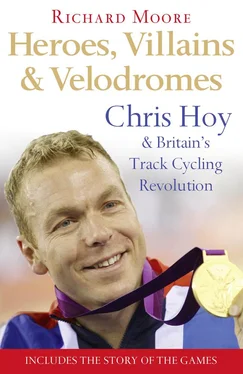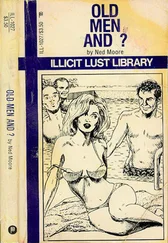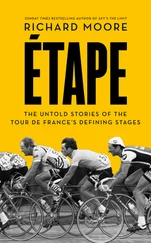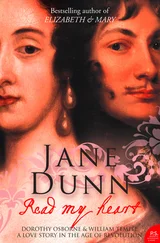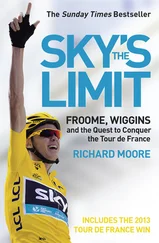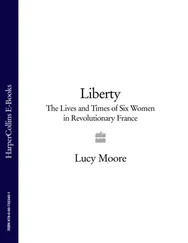‘His dad went with him and they were ushered into the office. David started to speak, but Tom Farmer interrupted him with, “That’s lovely Mr Hoy, but Christopher, tell me why you want this money. Sell it to me.”’ He did, and was rewarded with a cheque for £1,000 to assist with equipment and travelling expenses. Sir Tom Farmer, as he is now known, has kept in touch since, writing letters of congratulation to Hoy after the 2002 Commonwealth Games and 2004 Olympics. The owner of one of Edinburgh’s two big football clubs – Hibernian – obviously doesn’t hold it against Hoy that he is a confessed supporter of the other one, Hearts.
In his new team, Hoy cut a dash in his yellow and blue outfit, emblazoned with GT, Slazenger and Kwik-Fit. But that wasn’t a universal opinion. ‘I remember Chris because he had dodgy race gear,’ says Boyle. ‘I was reminded of how bad it was when I looked at some old pictures the other day. There aren’t many with Chris in them, but he’s always behind me, which is nice.’
In the end, Hoy’s BMX career, which spanned 1984 to 1991, and took him from the age of seven to fourteen, saw him ranked number one in Scotland for five years; he was Scottish champion, British number two (to Boyle), European number five and world number nine. Holland, France, Germany, Denmark and Belgium were all race destinations, giving him an early taste of travel and international competition.
David Hoy believes this also helped his education, in the widest sense of the word. ‘I remember standing at the Berlin Wall with him before it came down,’ says David. ‘In some of the big races in Europe there were teams from behind the Iron Curtain, on rubbish bikes, dressed in rags, really, and Chris used to be quite affected by that. I remember him saying, “It’s a shame for them Dad, because they’re good riders and if they had decent bikes they’d be really good.”’
As well as BMX-ing, Hoy declares his other early interests as maths and chess. On his first day at school – George Watson’s College in Edinburgh – the head teacher asked whether he had any questions. ‘Do you have a chess club?’ was his response. He describes maths as ‘a hobby’ – albeit an unusual one for a five year old. ‘When we went to my auntie’s I’d ask her to give me sums to do,’ says Hoy. ‘She’d write down a whole page of them and I’d sit there quite happily doing them. Then I got the Star Wars figures, about 130 of them altogether, and each one had a number next to the figure on the back of the packaging. I memorized the numbers. If you said “Forty-seven” I’d say “Imperial Storm Trooper!” Or you could say “Obe Wan Kanobi” and I’d say “Twenty-three!” I was about five or six at the time. I had weird little autistic tendencies.’
But it could be argued that maths and chess were compatible with BMX-ing: it, too, represented a puzzle that needed to be solved. Chiefly this concerned the start. It was the area that could be improved with thought, analysis and practice – three things that Hoy, even as a youngster, seemed to love. ‘The start is what I was known for,’ says Boyle. ‘My dad taught me at a young age not to wait for the gate to drop – then you’re using your eyes. He taught me to look ahead and use my ears – to listen to the command of the starter. And I could tell Chris started doing the same, because he was very quick out of the gate.’
‘Chris went out to the track in Livingston, about twenty miles away, twice a week, just to practise his starts,’ says David Hoy. ‘He’d go over it again and again. It’s very similar to the kilo, really. But Chris has always been into the technical side, the minutiae of it. He was always like that, looking into every little thing.’
Hoy senior agrees that BMX racing couldn’t have offered a better introduction to sport, and to cycling, from ‘learning to ride and race a bike, how to win and how to lose,’ and so there are certainly no regrets in the Hoy family about the seven years spent driving up and down the motorways of Britain, often in the company of other kids of different ages and backgrounds, or with Chris sleeping on a piece of foam in the back of the car, while plastic trophies melted on dashboards, with a bike that would be dismantled and rebuilt by dad on the kitchen table in midweek, before the routine was repeated the next weekend.
They were good days, says David – good for Chris, good for Dad, certainly good for father–son bonding. The strength of their relationship now probably owes much to the old BMX-ing days, and their ability back then to calmly, and rationally, analyse the different aspects of performance together, and to be gracious in victory and in defeat. ‘That was the deal with his BMX-ing,’ states Carol Hoy unequivocally, ‘that if he got beaten he didn’t lie on the track and throw his bike away.’
In fact, his father admits that he has only one regret. ‘It’s a tough, tough life being a cyclist, for very little reward. I wish I’d given him a set of golf clubs when he was a baby.’
Конец ознакомительного фрагмента.
Текст предоставлен ООО «ЛитРес».
Прочитайте эту книгу целиком, купив полную легальную версию на ЛитРес.
Безопасно оплатить книгу можно банковской картой Visa, MasterCard, Maestro, со счета мобильного телефона, с платежного терминала, в салоне МТС или Связной, через PayPal, WebMoney, Яндекс.Деньги, QIWI Кошелек, бонусными картами или другим удобным Вам способом.
